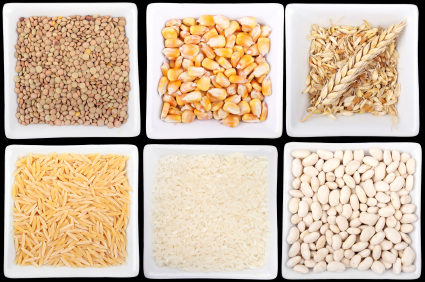Whole wheat, whole grain, enriched, refined…what does it all mean?
The basics: The grain kernel is composed of the germ, bran and endosperm (see photo below). This is how the kernels are naturally found when harvested and reaped.
- The Germ contains essential fatty acids, vitamin E, B vitamins, magnesium, folate and some protein.
- The Bran is rich in fiber (responsible for brown color of whole grain), B vitamins, minerals and antioxidants.
- The Endosperm contains mostly starch, with trace amounts of oils and protein.
- Associated with lower LDL and triglyceride levels, and therefore the risk of heart disease
- Consumption is inversely related to hypertension
- Shown to reduce the risk of type 2 diabetes and obesity
- Helps improve bowel health and promotes the growth of healthy bacteria in the colon, which may reduce the risk of stomach and intestinal cancers.
- Promotes healthy metabolism and a healthy nervous system
- The antioxidants, phenols, lignans and saponins present in whole grains may prevent cancer
In order to receive these health benefits you have to make sure the products you are consuming contain the grain kernel in its original form (with the germ, bran and endosperm intact). Unfortunately, this isn’t as simple as you would think. It’s easy to get confused when shopping at the grocery store nowadays with the endless numbers of products, deceiving marketing tactics and unrecognizable ingredient lists. More importantly, be wary of refined grains and enriched flour that all too frequently find their way into a vast majority of our food.
Refined Grains:
In an effort to increase the shelf life of products, manufacturers often process wheat through a refining method, by stripping the kernel of the germ and bran. This results in white, refined wheat. This means that the wheat is stripped of the nutrients mentioned above, namely the fiber and healthy fats.
Enriched Flour:
Enriched flour means that the nutrients and vitamins stripped during the refining process are added back in. Unfortunately, enriched flours don’t have the same nutritional benefits as whole-wheat flours. For starters, less fiber is present, causing blood sugar spikes. Key nutrients are also left out. Additionally, a different form of iron is added back in that is not as bioavailable as the form found in whole wheat alternatives.
In general, refined grains and enriched flours are metabolized much quicker and increase blood sugar more rapidly than their whole grain counterparts. They have been associated with increasing cholesterol and inflammation in the body as well.
How to distinguish if a product is made with whole-grains…ONLY!
First things first….forget the marketing claims on the packages of the foods you are purchasing. Just because they claim to be “100% whole grain,” “whole wheat,” “multigrain,” or “stone ground” doesn’t guarantee that you will be consuming a truly whole grain product. In fact, many of these products are composed mostly of refined flours, with marginal amounts of whole grains. Some manufacturers even color their products brown with molasses or caramel color to give the illusion of whole grains.
BOTTOM LINE: Skip straight to the ingredient lists, which will indicate if it is, in fact, a whole grain product.
- Amaranth
- Brown rice
- Buckwheat
- Bulgur
- Millet
- Popcorn
- Sorghum
- Teff
- Triticale
- Quinoa
- Whole-grain barley (hulled barley or hull-less)
- Whole-grain corn or whole corn
- Whole farro
- Whole kamut
- Whole oats/oatmeal
- Whole rye or rye berries
- Wild rice
- Whole spelt
- Whole grain ____ flour
- Whole white wheat*
- 100% whole wheat flour
*Whole white wheat is a whole grain, despite the white color. It has many of the nutritional advantages of traditional whole wheat, but with lighter color, milder taste and softer texture.
A good rule of thumb is to look for the word WHOLE preceding the grain. Note: Those grains listed above without the term “whole”, refer to grains that are very rarely made in processed form.
- Bread flour
- Degerminated
- Enriched flour
- Enriched wheat flour
- Flour
- Rice flour
- Unbleached wheat flour
- Wheat *
- Wheat flour *
- Wheat starch
*Pretty sneaky, huh?!?
Many products use a combination of grains or flours, so it’s important to check the whole list of ingredients.
Aim to make half the grains you consume daily to be whole grains as recommended by The 2010 USDA Dietary Guidelines. Don’t like the taste of whole wheat bread or brown rice? Give white whole wheat bread a try and explore some of the other grains mentioned above.
We did some investigating and discovered that the following products are not actually 100% whole grain. Busted!!!
|
Product |
Ingredient(s) in question |
| Cream of Wheat | Wheat farina, Partially defatted wheat germ |
| Kellogg’s Corn Flakes | Milled corn |
| Kellogg’s Eggo Nutri-Grain Whole Wheat Waffles | Enriched flour |
| Kellogg’s Product 19 | Milled corn and Wheat flour |
| Kellogg’s Special K | Rice, Wheat gluten, Defatted wheat germ |
| Luna Bars | Organic rice flour |
| Nabisco’s Wheat Thins | Unbleached enriched flour |
| Pepperidge Farm Light Style Seven Grain bread | Wheat Flour, Unbromated unbleached enriched flour |
| Pirate’s Booty | Corn meal and Rice |
Be your own detective and don’t be fooled my tricky marketing tactics!
In good health,
Melissa
Read more on whole grains at the Whole Grains Council website.
http://www.fns.usda.gov/fdd/facts/nutrition/WholeGrainsFactSheet.pdf
http://teamnutrition.usda.gov/resources/jtf_grains.pdf



